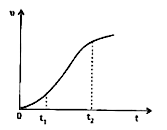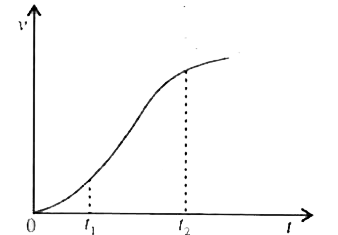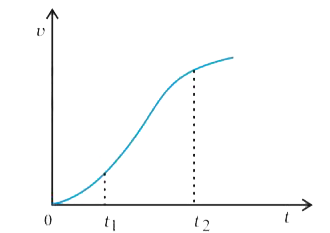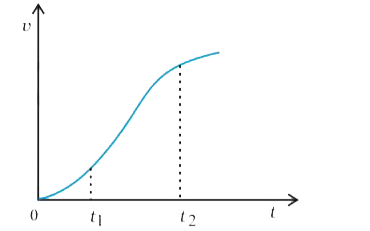The velocity-time graph of a particle in one-dimensional motion is shown in Fig.

Which of the following formulae are correct for describing the motion of the particle over the time-interval t1 to t2 :
a) x(t2)=x(t1)+v(t1)(t2−t1)+(12)a(t2−t1)2
b) v(t2)=v(t1)+a(t2−t1)
c) vaverage=(x(t2)−x(t1))/(t2−t1)
d) vaverage=(v(t2)−v(t1))/(t2−t1)
e) x(t2)=x(t1)+vaverage(t2−t1)+(12)aaverage(t2−t1)2
f) x(t2)=x(t1) = area under the v - t curve bounded by the t-axis and the dotted line shown.
From the graph we note that the slope is not constant and is not uniform, hence the relations (iii), (iv), (v) are correct.
Similar Questions
एकविमीय गति में किसी कण का वेग - समय ग्राफ चित्र में दिखाया गया है-

दिए सूत्रों में t1 से t2 तक के समय अंतराल की अवधि में कण की गति का वर्णन करने के लिए कौन - से सूत्र सही हैं
(i) x(t2)=x(t1)+v(t1)(t2−t1)+(1/2)a(t2−t1)2
(i8i) v(t2)=v(t1)+a(t2−t1)
(iii) vaverage=[x(t2)−x(t1)]/(t2−t1)
(iv) aaverage=[v(t2)−v(t1)]/(t2−t1)
(v) x(t2)=x(t1)+vaverage(t2−t1)+(1/2)aaverage(t2−t1)2
(vi) x(t2)−x(t1)=t− अक्ष तथा दिखाई गई बिंदुकित रेखा के बीच दर्शाए गए वक्र के अंतर्गत आने वाला क्षेत्रफल |
View SolutionThe velocity-time graph of a particle in one-dimensional motion is shown in Fig.

Which of the following formulae are correct for describing the motion of the particle over the time-interval t1 to t2 :
(a) x(t2)=x(t1)+υ(t1)(t2−t1)+(1/2)a(t2−t1)2
(b) υ(t2)=υ(t1)+a(t2−t1)
(c ) υaverage=(x(t2)−x(t1))/(t2−t1)
(d) aaverage=(υ(t2)−υ(t1))/(t2−t1)
(e ) x(t2)=x(t1)+υaverage(t2−t1)+(1/2)aaverage(t2−t1)2
(f) x(t2)−x(t1)= area under the υ−t curve bounded by the t-axis and the dotted line shown.
View SolutionThe velocity-time graph of a particle in one-dimensional motion is shown in Fig.

Which of the following formulae are correct for describing the motion of the particle over the time-interval t1 to t2 :
(a) x(t2)=x(t1)+υ(t1)(t2−t1)+(1/2)a(t2−t1)2
(b) υ(t2)=υ(t1)+a(t2−t1)
(c ) υaverage=(x(t2)−x(t1))/(t2−t1)
(d) aaverage=(υ(t2)−υ(t1))/(t2−t1)
(e ) x(t2)=x(t1)+υaverage(t2−t1)+(1/2)aaverage(t2−t1)2
(f) x(t2)−x(t1)= area under the υ−t curve bounded by the t-axis and the dotted line shown.
View SolutionProve that the point of intersection of the tangents at t1andt2 on the parabola y2=4ax is (at1t2,a(t1+t2))
View SolutionFor any arbitrary motion in space , which of the following relations are true : (a) Vaverage=(1/2)(v(t1)+v(t2))
(b) Vaverage=[r(t2)−r(t1)]/(t2−t1)
(c ) V(t)=V(0)+at
(d) r(t)=r(0)+v(0)T+(1/2)at2
(e ) aaverage=[v(t2)−v(t1)]/(t2−t1)
(The average stands for average of the quantity over the time interval t1 to t2)
View SolutionFor any arbitrary motion in space , which of the following relations are true : (a) V_("average")=(1//2)(v(t_(1))+v(t_(2))) (b) V_("average")=[r(t_(2))-r(t_(1))]//(t_(2)-t_(1)) (c ) V(t)=V(0)+at (d) r(t) =r(0)+v(0)T+(1//2)at^(2) (e ) a_("average")=[v(t_(2))-v(t_(1))]//(t_(2)-t_(1)) (The average stands for average of the quantity over the time interval t_(1)" to "t_(2))
View SolutionFor any arbitrary motion in space , which of the following relations are true : (a) Vaverage=(1/2)(v(t1)+v(t2))
(b) Vaverage=[r(t2)−r(t1)]/(t2−t1)
(c ) V(t)=V(0)+at
(d) r(t)=r(0)+v(0)T+(1/2)at2
(e ) aaverage=[v(t2)−v(t1)]/(t2−t1)
(The average stands for average of the quantity over the time interval t1 to t2)
View SolutionFor any arbitrary motion in space , which of the following relations are true : (a) Vaverage=(1/2)(v(t1)+v(t2))
(b) Vaverage=[r(t2)−r(t1)]/(t2−t1)
(c ) V(t)=V(0)+at
(d) r(t)=r(0)+v(0)T+(1/2)at2
(e ) aaverage=[v(t2)−v(t1)]/(t2−t1)
(The average stands for average of the quantity over the time interval t1 to t2)
View Solution
